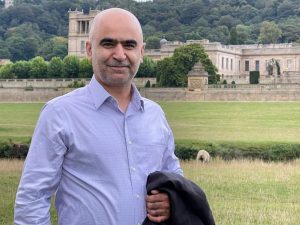
The gentlemen’s agreement among three main political leaders (Sadr, Halbousi, and Barzani) strongly affected the political perspective in Iraq. The informal agreement that attempts to form the National Majority Government (NMG), as emerged, is not a grand coalition agreement, but it could be described as a semi-grand coalition. The reason for that is powerful entities from the main communities have involved and mostly achieved an absolute majority of the Council of Representatives – CoR. At the first step, the semi-grand coalition succeeded in what was planned for re-electing the presidency of the fifth CoR and re-elected Speaker Al-Halbousi (Sunni), the first deputy of the Speaker Hakm Al-Zamli (Sadrist), and the second deputy Shakhwan Abdullah (Kurdistan Democratic Party- KDP).
The new approach divided the Shiite into two groups: the Sadrist movement and the Coordination Framework- CF. Sadr is demanding a national majority government for the incoming cabinet, while the consensus government is the only option for the CF, which was implemented partially post invasion. On the other side, the Kurds are deeply divided between the Sadrist movement and CF; KDP is one of the main allies of the Sadrist movement and the Patriotic Union of Kurdistan- PUK is close to the CF. The main issue between both Kurdish parties is the position of President each one demanded to take it for the next four years. Thus, the semi-grand coalition contributed to make the gap wider inside communities toward re-shaping political process. Ongoing negotiations with CF did not develop and they are still insisting on consensus government as the best solution. While the CF hold onto their political project and the Sadrist do not negotiate on that perspective, the majority approach is based on the formal document.
Based on the Iraqi permanent constitution, there is an explicit article that gives the right to the largest bloc to form the government. This is clearly stated in Article 76, section 1: “the President of the Republic shall charge the nominee of the largest Council of Representatives bloc with the formation of the Council of Ministers.” This seems to be the majoritarian model, especially when the approval of the cabinet required an absolute majority of the CoR, as stated in article 76, section 4. However, the constitution does not allow a single community to govern Iraq, even if they achieve an absolute majority. It is therefore highly unlikely that a single ethnic group or single political party could successfully govern the entire country without some form of coalition with other communities. This means one group cannot govern Iraq without support from the others, and there is no guarantee of getting an absolute majority from CoR for approving the cabinet in the parliament. This ‘stalemate’ situation therefore encourages main blocs in all communities to form a coalition in order to form a majority government that get support from the constitution.
The design of the NMG cabinet is controversial and negotiations are still ongoing with others to join the “semi-grand coalition”. The Sadrist mission is to make the current “semi-grand coalition” govern by an absolute majority seats in the CoR. However, Sadr is negotiating with the CF to participate in that cabinet without Maliki. In that case, if they agreed with Sadr’s proposal to share the new cabinet, it could not be the majority government. It would be the same as previous cabinets that included all of them. Thus, there is no clear vision of how the new government framework might operate. It requires more clarification, but there is significant pressure to bring the majority government to power.
While formally there is not any barrier for the NMG, there is no guarantee of success in practice. A real obstacle to implementing the cabinet might come from the CF. They are clearly against that kind of proposal and if they get an approval from the CoR, the new cabinet would have a powerful opposition. The reason is that the CF has the power to make difficulties for majority government to be stabilized. It is obvious that in such a deeply divided society, such as Iraq, it is highly unlikely majority government would be formed by a single community or even with a selected political party from each community, while other political entities, are willing to share power and take a part of the stake. They are fighting to participate in the cabinet, and if not let in, the situation would be made worse. This means the NMG, beside the divided society, could lead to divided communities as well, which in turn would lead to instability.
Consequently, the new situation which has faced political process after Saddam’s regime is that the NMG took one step forward by constructing the semi-grand coalition. The semi-grand coalition is one of the main points that led to change in the previous political formula for building the political institutions. Negotiation is still ongoing and there is a chance for others to participate in the cabinet, but at that point the NMG could get another form because there would be no majority government if all participated. The design of the NMG is not shaped yet or at least not published which could be related to the unclear vision about the end of process could be. The ideal module is to represent all communities, but there is no idea on how those parties obtain positions in the cabinet. Implementation is not an easy way to adopt the NMG because of the division and armed opposition from the Shiite side. Thus, there is possibility that the NMG, and semi-grand coalition may make this less complicated, but it also needs a transfer period to formulate the majority government and to consider any unexpected reactions.
